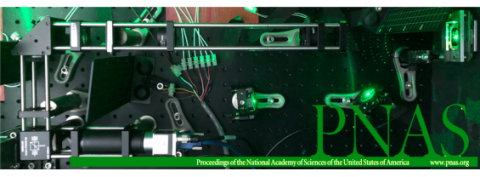The first optical computation of the Spin-Glass dynamics

Spin Glasses are paradigmatic model systems that - besides their intrinsic interest in fundamental statistical mechanics - can mimic a wide range of physical systems spanning from topological glasses to stock market evolution, with functional applications in brain physics and neural networks.
The numerical computer simulation of the Spin Glass dynamics with long-range interactions is extremely complex and computationally challenging. Indeed, the determination of the coupling terms between all the spin pairs grows quadratically with the number of degrees of freedom. The search for a solution to this, stimulated the development of both sophisticated and efficient parallel algorithms as well as dedicated silicon-based hardware. These efforts led to a paramount application facet: the modeling of memory storage and recovery thanks to Hopfield neural networks a paradigmatic system behaving as a Spin Glass.
In a recent paper, resulting from synergic collaboration between Marco Leonetti and Luca Leuzzi (CNR Nanotec), Giancarlo Ruocco (CLNS-IIT and department of Physics, Sapienza University), and Giorgio Parisi (Accademia dei Lincei and department of Physics, Sapienza University), new optical hardware for the optical simulation of Spin Glasses has been proposed.
The new optical computer developed within the CLN2S-IIT labs in Rome, enables the calculation of the energy of the spin interaction at the “speed of light,” i.e., in the time needed for a light pulse to transmit through a disordered diffusing system of size comparable to the photons mean free path (hundredths of microns). The spin coupling indeed is mapped on the specific realization of the disorder and, in the performed experiment, has an exponential distribution. The spins are mapped into the on-off status of the mirrors of a fast adaptive optical Digital Micromirror Device (DMD), which allows flipping the spins in about 30 us. Each “spin” controls the presence of a portion of the light beam impinging on the disordered sample, thus defining the wavefront of the beam. The DMD drives the state of one million light rays simultaneously and updates the Spin state at the speed of 32000 times per second.
Altogether, we presented a novel spin-glass optical computer, with a computation time scales that varies linearly with the number of spins. Thus, the implemented version of such computer was employed to experimentally demonstrate that the “optical supremacy”, compared to the silicon computer, is reached when 10^4 spins are simulated.
Authors
Marco Leonetti, Erik Hörmann, Luca Leuzzi, Giorgio Parisi and Giancarlo Ruocco.
Reference
PNAS: https://www.pnas.org/content/118/21/e2015207118
